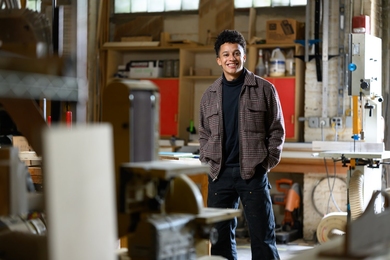Eighteen MIT scientists are part of the team that announced yesterday the first direct evidence for the top quark, the last of the subatomic particles believed to be the building blocks of matter.
The international team of 439 scientists is based at the Fermi National Accelerator Laboratory, home of the Tevatron accelerator where the work was conducted. The MIT group, which is composed of scientists from the Department of Physics and the Laboratory for Nuclear Science, is led by Assistant Professor Paraskevas Sphicas of physics. Professor Sphicas played a major role in developing one of the analysis approaches that form the basis for the new evidence.
This evidence "is very significant," said Lawrence Rosenson, a professor of physics and a member of the MIT group. That's because "the current model of particle physics, the so-called Standard Model, which is our best view right now of how the universe works, depends crucially on the discovery of this last quark," he said.
"Until now only five quarks had been identified," Professor Rosenson continued, but the Standard Model predicted a sixth. "So essentially since 1977 (when the fifth quark, the bottom quark, was discovered), we've been looking for this object. It has turned out to be very difficult to find."
Professor Rosenson noted that at this point the Fermi team "is still steering clear of calling this the firm discovery of the top quark; rather, we believe that we have strong, though statistically limited, evidence for its existence. More data will be obtained within the next year or so, which we hope will confirm the existence of this quark."
In discussing MIT contributions to the work, Professor Rosenson said that Professor Sphicas "played a pioneering role in developing one of the analysis approaches that form the basis for this current new evidence."
Members of the MIT team in addition to Professors Sphicas and Rosenson are: Institute Professor and Nobel laureate Jerome Friedman, Research Scientist Gerry Bauer, Postdoc Jose Benlloch, Postdoc Robert Mattingly, Principal Research Scientist Konstanty Sumorok, Research Scientist Stephen Tether, and Steven Pavlon, sponsored research technical staff. All are in the Laboratory for Nuclear Science; the faculty members are also in the Department of Physics.
The following physics graduate students are also on the team. At MIT are Paul Ngan, Vincenzo Lia, Dejan Vucinic, and Tushar Shah; at Fermi Lab are Wasiq Bokhari, Troy Daniels, Ken Kelley and Petar Maksimovic. In addition, team member Baber Farhat received the PhD in physics from MIT this January.
The 440-member Fermilab team that made the announcement, formally known as the Collider Detector at Fermilab collaboration (or CDF), submitted a research paper on their findings last Friday to the journal The Physical Review. Fermilab is a Department of Energy National Laboratory.
A version of this article appeared in the April 27, 1994 issue of MIT Tech Talk (Volume 38, Number 30).





